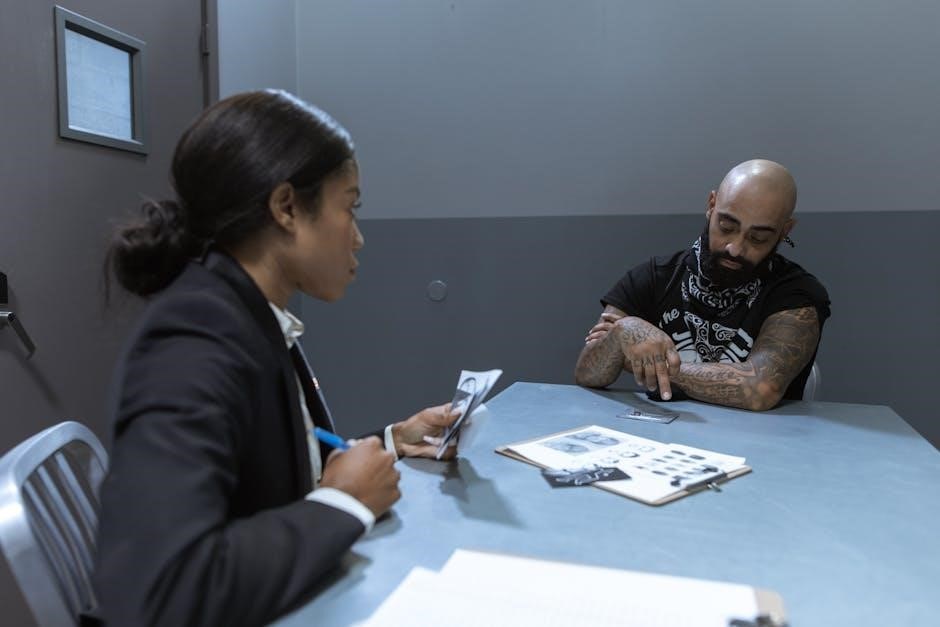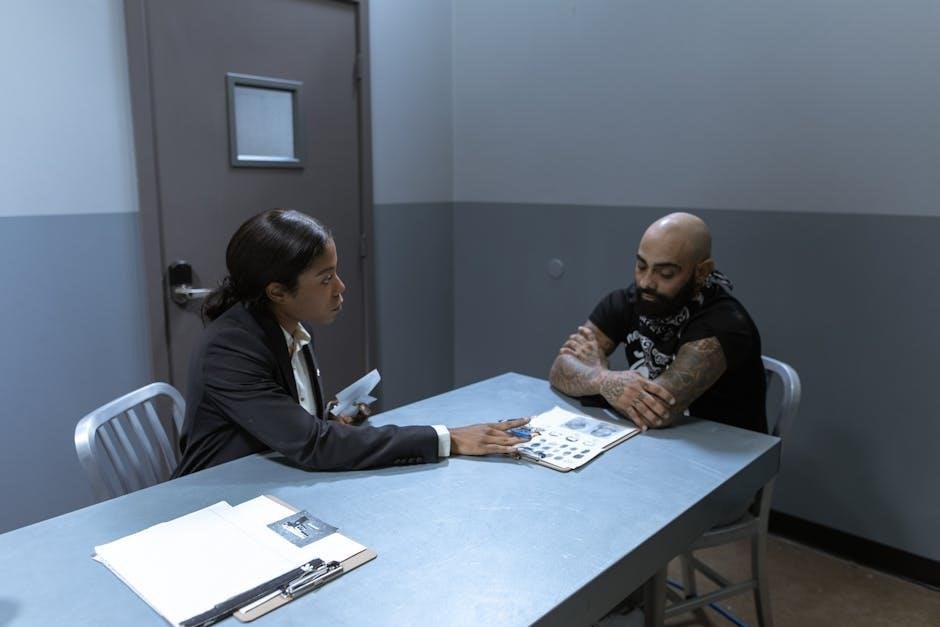Preparing for a principal interview requires understanding common questions and crafting thoughtful responses․ This guide covers key topics, from leadership philosophy to school improvement strategies, helping candidates succeed․
Overview of the Importance of Preparation
Preparation is crucial for acing principal interviews, as it demonstrates professionalism and readiness for the role․ Researching the school, practicing responses, and understanding key issues ensures confidence․ Reviewing common questions helps align answers with the school’s goals․ Preparation also showcases problem-solving skills and leadership qualities, highlighting your ability to address challenges effectively․ Being well-prepared not only enhances your credibility but also positions you as a visionary leader capable of driving school success․
Common Themes in Principal Interview Questions
Principal interview questions often focus on leadership, vision, and problem-solving․ Themes include educational philosophy, improving student outcomes, and managing school culture․ Candidates are asked about their experience, strengths, and strategies for addressing challenges like academic underperformance or disciplinary issues․ Additionally, questions explore how candidates engage stakeholders, foster collaboration, and adapt to change․ Understanding these themes helps candidates tailor responses to demonstrate their qualifications and alignment with the school’s mission and values․ Preparation is key to addressing these critical areas effectively․ Schools seek leaders who can inspire growth and ensure student success in a dynamic educational environment;

Common Principal Interview Questions
Interviews for principal roles often include questions about strengths, vision, leadership style, and handling challenges․ Candidates must articulate clear strategies for school improvement and student success effectively․
Strengths and Weaknesses
When discussing strengths, highlight leadership skills, communication abilities, and dedication to student success․ For weaknesses, acknowledge areas like delegation challenges and provide examples of proactive steps taken to improve, demonstrating self-awareness and growth․
Vision for School Improvement
A clear vision for school improvement should focus on enhancing academic performance, fostering a positive culture, and ensuring equitable opportunities․ Emphasize strategic planning, stakeholder engagement, and measurable goals․ Highlight initiatives like professional development, technology integration, and community partnerships to demonstrate a comprehensive approach to driving progress and achieving long-term success for all students and staff․
Educational Philosophy and Leadership Style
Your educational philosophy should reflect a student-centered approach, emphasizing inclusivity, equity, and academic excellence․ Discuss how your leadership style fosters collaboration, innovation, and accountability․ Highlight your belief in professional development, community engagement, and data-driven decision-making․ Share how you create a positive school culture that supports both students and staff, ensuring everyone feels valued and empowered to contribute to the school’s mission and goals․
Handling Challenges and Conflict
Effective principals must address challenges and conflicts with diplomacy and strategic thinking; Discuss your approach to resolving disputes among students, staff, or parents․ Highlight active listening, empathy, and fair problem-solving; Emphasize restorative practices and fostering a culture of respect․ Share examples of how you’ve managed difficult situations, ensuring all voices are heard and solutions align with the school’s values․ Demonstrate how you prioritize maintaining a positive environment while addressing conflicts constructively․

Behavioral Interview Questions for Principals
Behavioral questions assess your past actions and decisions․ Be ready to share specific examples of leadership, problem-solving, and conflict resolution․ Highlight your approach to collaboration and innovation․
Describe a Time You Implemented Significant Change
When faced with declining student engagement, I led a school-wide initiative to integrate technology into classrooms․ I assessed needs, developed a plan, and trained staff․ Collaboration with teachers and students ensured smooth implementation․ The initiative boosted engagement and improved academic performance, demonstrating my ability to drive meaningful change through strategic planning and stakeholder involvement․ This experience highlights my commitment to innovation and improving educational outcomes․
How You Handle Difficult Situations with Staff or Students
I approach difficult situations with empathy and a solution-oriented mindset․ For example, when a teacher and parent disagreed on a student’s progress, I facilitated an open discussion to understand both perspectives․ By actively listening and focusing on shared goals, we developed a collaborative plan that supported the student’s success․ This approach fosters trust and ensures that challenges are resolved constructively, maintaining a positive school environment․
Examples of Successful Team Collaboration
I led a cross-functional team to implement a new curriculum aligned with state standards․ By fostering open communication and empowering each member to contribute, we achieved seamless integration across all grade levels․ Regular feedback sessions and collaborative problem-solving ensured the initiative’s success․ This teamwork not only enhanced academic outcomes but also strengthened staff morale and cooperation, creating a culture of shared responsibility and collective achievement․

Questions About Educational Background and Experience
Discussing your educational background and professional experience highlights your qualifications․ Be prepared to share how your journey as an educator has prepared you for the principal role․
Tell Us About Your Educational Background
Highlight your academic journey, including degrees earned and certifications․ Emphasize how your education aligns with the principal role, such as a Master’s in Education or Leadership․ Mention any specialized training or professional development that enhances your qualifications․ Connect your academic background to your leadership approach and commitment to student success, demonstrating how your education has prepared you to lead effectively and foster a positive school environment․
Professional Experience Relevant to the Principal Role
Discuss your leadership roles in education, such as assistant principal or department head․ Highlight hands-on experience in curriculum development, staff supervision, and student support․ Emphasize achievements in improving academic performance or fostering collaboration․ Mention any experience with budget management or community engagement․ Connect your past roles to the principal’s responsibilities, showcasing how your background prepares you to lead effectively and drive student success․ Tailor your examples to align with the school’s mission and goals․
How Your Experience Prepares You for This Position
Your experience equips you with the skills and insights needed to excel as a principal․ Highlight specific achievements, such as improving academic outcomes or fostering a positive school culture․ Discuss how your leadership roles have prepared you to manage budgets, lead staff, and engage the community․ Connect your past successes to the challenges the school faces, demonstrating how your background aligns with the institution’s goals․ Emphasize your ability to adapt and grow, ensuring you’re ready to lead effectively from day one․

Leadership and Management Questions
Leadership and management questions assess your ability to inspire, motivate, and guide a school community․ Be prepared to discuss your vision, strategies for conflict resolution, and methods for fostering a positive culture․
Your Approach to School Leadership
Your approach to school leadership should reflect a balance between vision, collaboration, and accountability․ Highlight your ability to inspire staff, engage students, and foster a positive school culture․ Emphasize clear communication, decision-making processes, and how you empower teachers and students․ Discuss your strategies for addressing challenges while maintaining a student-centered focus․ Show how you align leadership practices with the school’s mission and goals to create a supportive and inclusive learning environment․
Strategies for Motivating Staff and Students
Effective strategies for motivating staff and students involve creating a supportive environment that fosters growth and recognition․ For staff, provide professional development opportunities, constructive feedback, and celebrate achievements․ For students, incorporate engaging lesson plans, set achievable goals, and offer incentives․ Encourage collaboration and ownership through student-led projects and peer recognition programs․ Motivation thrives when individuals feel valued, challenged, and supported, leading to a positive and productive school culture․
How You Foster a Positive School Culture
Fostering a positive school culture begins with clear communication and shared values․ Encourage inclusivity, respect, and empathy among all members of the school community․ Recognize and celebrate student and staff achievements to build morale․ Implement restorative practices to address conflicts constructively․ Lead by example, demonstrating transparency and approachability․ A positive culture also involves engaging families and the community, ensuring everyone feels connected and valued․ These efforts create a nurturing environment where students and staff thrive academically and emotionally․

Questions About School Challenges and Solutions
Addressing academic underperformance and improving student discipline are key challenges․ Strategies include targeted interventions, collaborative problem-solving, and fostering a supportive learning environment to drive positive outcomes and growth․
Addressing Academic Underperformance
Addressing academic underperformance requires a data-driven approach, identifying areas of weakness, and implementing targeted interventions․ Principals should emphasize early identification of at-risk students, provide additional support through tutoring or enrichment programs, and foster collaboration between teachers, parents, and students․ Professional development for teachers can enhance instructional strategies, while recognizing and rewarding progress motivates students․ A culture of high expectations, coupled with resources and support, helps improve academic outcomes and ensures equitable opportunities for all learners․
Improving Student Discipline and Behavior
Improving student discipline and behavior involves creating a structured, supportive environment with clear expectations and consistent consequences․ Principals should promote positive behavioral interventions, such as restorative practices and social-emotional learning, to address root causes of misconduct․ Encouraging teacher-student relationships and fostering a sense of community can reduce conflicts․ Training staff on effective classroom management and collaborating with parents ensures a unified approach to fostering respect, responsibility, and self-discipline among students, leading to a safer and more focused learning environment․
Strategies for Increasing Parental Involvement
Effective strategies to increase parental involvement include fostering open communication through regular updates and accessible channels․ Principals should organize engaging events, such as parent-teacher conferences, workshops, and volunteer opportunities, to encourage participation․ Building trust and creating a welcoming school environment also plays a crucial role․ Leveraging technology, like newsletters and parent portals, helps keep families informed․ By valuing parents’ contributions and ensuring their voices are heard, principals can strengthen partnerships that support student success and overall school improvement․
Community and Stakeholder Engagement
Building strong relationships with the community and stakeholders is vital for school success․ Principals should foster collaboration through open communication, inclusive decision-making, and engaging events that promote partnerships․
Building Relationships with the School Community
Building strong relationships with the school community involves active listening, transparency, and mutual respect․ Principals should engage parents through regular meetings, volunteer opportunities, and clear communication․ Fostering trust with local businesses and organizations can also enhance resources and support for students․ By creating an inclusive environment, principals can ensure all stakeholders feel valued and involved in the school’s mission and goals․
Communicating Effectively with Parents and Stakeholders
Effective communication with parents and stakeholders is crucial for a principal’s success․ Regular updates through newsletters, emails, and meetings ensure transparency․ Principals should listen actively to concerns, provide clear responses, and involve parents in decision-making processes․ Utilizing diverse communication channels, such as social media and parent-teacher organizations, can broaden engagement․ By fostering open dialogue, principals build trust and collaboration, ensuring a united effort in supporting student success and school improvement․
Engaging Students in Decision-Making Processes
Engaging students in decision-making fosters leadership skills and a sense of ownership․ Principals can create student councils or committees to involve them in school policies, events, and initiatives․ Encouraging open forums and surveys allows students to voice opinions on matters affecting them․ By valuing their input, principals empower students to contribute meaningfully, enhancing their engagement and preparing them for future leadership roles․ This approach strengthens the school community and promotes a collaborative environment․

Professional Development and Growth
Professional development is crucial for educators and students․ Principals should support continuous learning, fostering growth opportunities for staff and promoting innovative educational practices to enhance school success․
Your Commitment to Continuous Learning
Demonstrating a commitment to continuous learning is essential for principals․ This involves pursuing professional development opportunities, such as workshops, conferences, and advanced certifications, to stay updated on educational trends․ Principals should model lifelong learning for staff and students, fostering a growth mindset within the school community․ By prioritizing personal and professional growth, principals can innovate and lead effectively, ensuring the school remains aligned with modern educational standards and goals․ Continuous learning enhances leadership and instructional strategies, benefiting both students and staff․
How You Support Professional Development for Staff
Supporting professional development for staff is crucial for fostering a growth-oriented school culture․ Principals can facilitate this by providing access to workshops, training sessions, and opportunities for collaboration․ Encouraging teachers to pursue certifications and attend conferences helps them stay updated on best practices․ Additionally, creating mentorship programs and offering feedback through regular evaluations can enhance staff capabilities․ By investing in the professional growth of educators, principals ensure high-quality instruction and a motivated workforce, ultimately benefiting student achievement and school success․
Your Vision for Innovation in Education
Your vision for innovation in education should focus on integrating technology, fostering creativity, and promoting personalized learning․ Emphasize the importance of adapting to modern educational trends, such as AI-driven tools and virtual reality, to enhance student engagement․ Highlight the need for professional development to equip teachers with innovative teaching methods․ By prioritizing innovation, schools can prepare students for future challenges and create a dynamic, forward-thinking learning environment that encourages collaboration and critical thinking․

Financial and Resource Management
Effective financial and resource management is crucial for school success․ Key strategies include managing school budgets effectively, securing funding through grants, and strategically allocating resources to prioritize student needs․
Managing School Budgets Effectively
Managing school budgets effectively involves prioritizing spending to align with academic goals, ensuring transparency in financial decisions, and optimizing resource allocation․ Principals must balance immediate needs with long-term investments, such as technology upgrades or professional development, while maintaining fiscal responsibility․ Effective budget management also requires identifying cost-saving measures, leveraging grants, and engaging stakeholders to support resource utilization․ Strong financial planning ensures equitable access to resources, fostering a conducive learning environment and sustainable school operations․
Strategies for Securing Funding and Resources
Securing funding and resources requires proactive strategies, such as applying for grants, building partnerships with local businesses, and engaging the community․ Principals should identify funding opportunities through government programs, foundations, and corporate sponsorships․ Leveraging data to demonstrate needs and showcasing success stories can strengthen grant applications․ Collaborating with stakeholders, such as PTAs and local organizations, can also help secure resources․ Effective communication of the school’s vision and goals is essential to attract support and ensure sustainable funding for educational initiatives․
Allocating Resources to Meet School Priorities
Allocating resources effectively involves aligning budget and materials with school priorities, such as academic programs and student support․ Principals should assess needs, prioritize expenditures, and ensure transparency․ Data-driven decisions help optimize resource distribution, while regular monitoring ensures alignment with goals․ Collaboration with teachers and staff fosters a shared understanding of resource allocation․ By strategically distributing funds and materials, principals can enhance educational outcomes and create an environment that supports student success and school-wide objectives․

Strategic Planning and Vision
Strategic planning involves setting clear, measurable goals aligned with the school’s mission․ A strong vision ensures all stakeholders work collaboratively toward long-term success․
Developing a Long-Term Vision for the School
Creating a long-term vision requires collaboration with teachers, students, and parents to establish clear, measurable goals․ It involves assessing current performance, identifying areas for growth, and aligning resources to achieve strategic objectives․ A strong vision ensures the school remains focused on academic excellence, student well-being, and continuous improvement․ Principals must communicate this vision effectively to inspire and guide the school community toward a shared future․
Aligning Goals with the School Improvement Plan
Aligning goals with the school improvement plan ensures a cohesive strategy for achieving educational objectives․ Principals must analyze the plan, identify key priorities, and integrate them into daily operations․ This involves setting measurable targets, allocating resources effectively, and monitoring progress․ By aligning goals with the improvement plan, schools can address specific needs, enhance student outcomes, and maintain accountability․ Regular assessments and adjustments ensure the strategy remains relevant and impactful over time․
Measuring Success and Tracking Progress
Measuring success and tracking progress are critical for evaluating the effectiveness of school initiatives․ Principals should establish clear metrics aligned with school goals, such as academic performance, student engagement, and teacher satisfaction․ Regular assessments, data analysis, and progress reports help identify strengths and areas for improvement․ By maintaining a data-driven approach, principals can make informed decisions, adjust strategies, and ensure continuous growth․ This process fosters accountability and supports the overall mission of enhancing student outcomes and school performance․

Final Questions and Next Steps
Concluding the interview, candidates should ask insightful questions to the panel, demonstrating genuine interest and engagement․ Following up with a thank-you note is essential, expressing gratitude and reiterating enthusiasm for the role․ Additionally, preparing for potential next-round interviews ensures readiness to further discuss qualifications and vision for the school’s future․
What Questions Should You Ask the Interview Panel?
Asking thoughtful questions during the interview demonstrates engagement and interest in the role․ Consider inquiring about the school’s specific challenges, the community’s expectations, and how success is measured․ Questions like, “What are the immediate priorities for the new principal?” or “How does the school currently support teacher development?” showcase a proactive approach․ Tailor your questions to the school’s unique context, avoiding generic inquiries․ This strategy highlights your preparation and genuine interest in the position․
How to Follow Up After the Interview
Following up after the interview is crucial to leave a positive impression․ Send a thank-you email or letter within 24 hours, expressing gratitude for the opportunity and reiterating your interest in the role․ Briefly mention key discussions or points that resonated with you, showcasing your alignment with the school’s goals․ This practice not only demonstrates professionalism but also reinforces your enthusiasm for the position and commitment to the school’s success․
Preparing for the Next Round of Interviews
After advancing to the next round, delve deeper into the school’s specific challenges and goals․ Review the district’s strategic plan and familiarize yourself with current initiatives․ Anticipate more detailed questions about your leadership experience and vision for the school․ Prepare examples of successful strategies you’ve implemented and how they align with the school’s needs․ Practice articulating your approach to complex scenarios, and gather any requested documents, such as references or portfolio samples, to present a polished and professional image․
Acing a principal interview requires preparation, authenticity, and confidence․ By understanding common questions and showcasing your vision and experience, you can leave a lasting impression and secure the role․
Key Takeaways for Acing the Principal Interview
To excel in a principal interview, focus on showcasing your leadership vision, educational philosophy, and problem-solving skills․ Prepare thoughtful responses to common questions, emphasizing your experience and achievements․ Demonstrate a clear understanding of school challenges and offer innovative solutions․ Highlight your ability to foster collaboration and improve student outcomes․ Authenticity and confidence are key, as interviewers seek a genuine leader who aligns with the school’s mission and values․
The Importance of Authenticity and Confidence
Authenticity and confidence are essential in a principal interview․ Be genuine in sharing your experiences and beliefs, ensuring your responses align with your true self․ Confidence demonstrates your readiness to lead and make impactful decisions․ Avoid exaggeration; instead, showcase your strengths and acknowledge areas for growth․ Trust in your abilities and passionately articulate your vision for the school․ This authenticity and self-assurance will help you connect with the interview panel and stand out as a compelling candidate․
Final Tips for Success
To excel in your principal interview, thoroughly research the school and align your responses with its mission and goals․ Practice articulating your vision, leadership style, and strategies for improvement․ Showcase enthusiasm and a growth mindset, demonstrating how you can foster a positive school culture․ Be prepared to provide specific examples from your experience and follow up with a thank-you note․ Confidence, clarity, and genuine passion will leave a lasting impression and increase your chances of success․